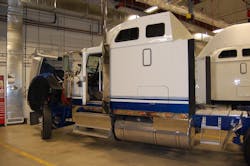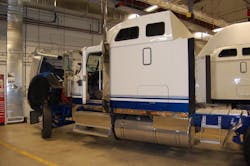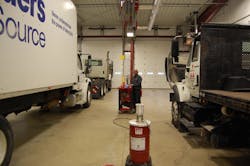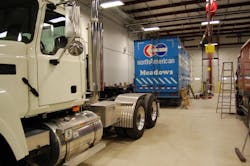The reason is pretty simple: much like every other truck maker out there, Navistar is turning over every rock it can to figure out ways to maximize vehicle uptime for its customers. And getting dealers to reconfigure their maintenance protocols in order to speed up repairs is critical to that uptime mantra.
“The eyes of customer are on uptime; that’s where the rubber hits the road,” noted Michael Cancelliere, Navistar’s senior VP of global parts and customer service during a conference call with reporters.
He said the rule of thumb among most customers is that it costs $1,000 a day to have a truck down in the shop and thus not running on the road. “And that’s on the low side,” Cancelliere stressed.
“So while all our strategies are important – offering more fuel efficiency packages for our trucks, for example – uptime is the one we really need to be aligned around,” he added.Other OEMs are pursuing the very same goal: witness for example the efforts of Mack Trucks, Volvo Trucks, Peterbilt Motor Co., and Kenworth Truck Co. in the uptime arena.
Yet while Navistar’s uptime strategy is aimed at getting trucks serviced faster – aiming for a “virtual triage” on a vehicle to be completed no later than two hours after it enters the shop, noted Reiter, with an accurate diagnosis and estimated “fix time” provided to the customer – it’s also aimed at making dealerships truly “one stop shops.”
Reiter pointed out, for example, that a key linchpin to the “Diamond Edge” certification program is that dealerships be linked into the OEM’s OnCommand Connection telematics system rolled out two years ago.
“We’ve got 170,000 vehicles now linked to OnCommand, and more than half of them are our competitor’s trucks,” he said. “One critical point of this program is that we prevent customers from having to take their truck from shop to shop to shop to get repairs completed. So now if there is Cummins engine or an Eaton transmission issue, the diagnostic trees are available through OnCommand so our dealers can work on them.”Reiter also noted that all this focus on vehicle uptime applies equally to Navistar’s heavy- and medium-duty product portfolio alike.
Interestingly, he added that the “Diamond Edge” effort isn’t really “new” either, as the OEM pilot tested the program among its Canadian dealerships two years ago and has, by now, put all of its 740 dealer locations through its training protocols.
“By the end of the first quarter of next year we’ll be ready to publish the list of dealers certified under the program,” Reiter said.
However, he stressed that such “certification” will only be granted to those dealerships that meet the programs service time metrics, not whether they’ve made all the required investments and procedural changes.
“If it doesn’t all come together on the back end – if the repair isn’t performed according to the metrics we’ve established – then we’ve missed our customer expectations,” Reiter noted. “But so far the program is working; we’re seeing significant improvement in average dwell time and 24 hour repair cycles. We’re very pleased with collaboration we’ve received from dealers; it demonstrates that we’re all together in our commitment to uptime improvement.”



